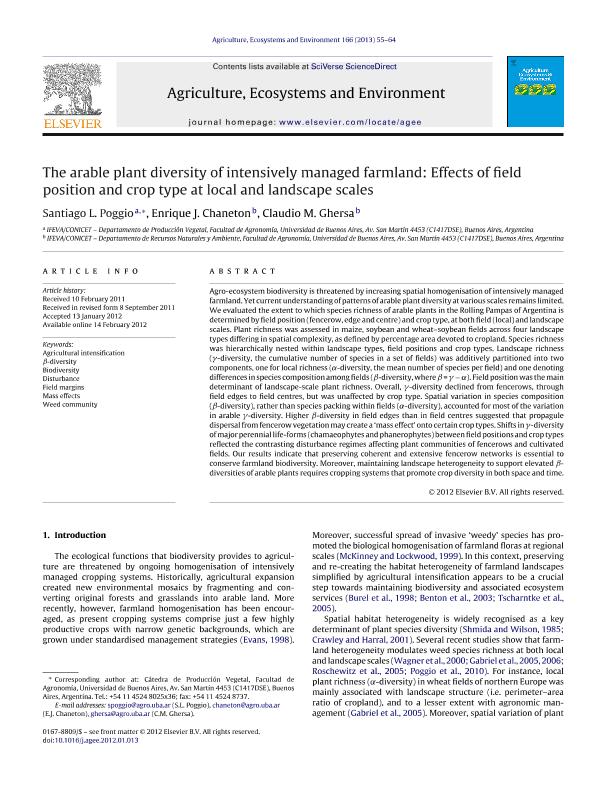Mostrar el registro sencillo del ítem
dc.contributor.author
Poggio, Santiago Luis

dc.contributor.author
Chaneton, Enrique Jose

dc.contributor.author
Ghersa, Claudio Marco

dc.date.available
2016-02-11T19:48:05Z
dc.date.issued
2013-02-14
dc.identifier.citation
Poggio, Santiago Luis; Chaneton, Enrique Jose; Ghersa, Claudio Marco; The arable plant diversity of intensively managed farmland: effects of field position and crop type at local and landscape scales; Elsevier; Agriculture, Ecosystems and Environment; 166; 14-2-2013; 55-64
dc.identifier.issn
0167-8809
dc.identifier.uri
http://hdl.handle.net/11336/4148
dc.description.abstract
Agro-ecosystem biodiversity is threatened by increasing spatial homogenisation of intensively managed farmland. Yet current understanding of patterns of arable plant diversity at various scales remains limited. We evaluated the extent to which species richness of arable plants in the Rolling Pampas of Argentina is determined by field position (fencerow, edge and centre) and crop type, at both field (local) and landscape scales. Plant richness was assessed in maize, soybean and wheat–soybean fields across four landscape types differing in spatial complexity, as defined by percentage area devoted to cropland. Species richness was hierarchically nested within landscape types, field positions and crop types. Landscape richness (γ-diversity, the cumulative number of species in a set of fields) was additively partitioned into two components, one for local richness (α-diversity, the mean number of species per field) and one denoting differences in species composition among fields (β-diversity, where β = γ − α). Field position was the main determinant of landscape-scale plant richness. Overall, γ-diversity declined from fencerows, through field edges to field centres, but was unaffected by crop type. Spatial variation in species composition (β-diversity), rather than species packing within fields (α-diversity), accounted for most of the variation in arable γ-diversity. Higher β-diversity in field edges than in field centres suggested that propagule dispersal from fencerow vegetation may create a ‘mass effect’ onto certain crop types. Shifts in γ-diversity of major perennial life-forms (chamaeophytes and phanerophytes) between field positions and crop types reflected the contrasting disturbance regimes affecting plant communities of fencerows and cultivated fields. Our results indicate that preserving coherent and extensive fencerow networks is essential to conserve farmland biodiversity. Moreover, maintaining landscape heterogeneity to support elevated β-diversities of arable plants requires cropping systems that promote crop diversity in both space and time.
dc.format
application/pdf
dc.language.iso
eng
dc.publisher
Elsevier

dc.rights
info:eu-repo/semantics/openAccess
dc.rights.uri
https://creativecommons.org/licenses/by-nc-nd/2.5/ar/
dc.subject
Agricultural Intensification
dc.subject
Beta Diversity
dc.subject
Biodiversity
dc.subject
Disturbance
dc.subject
Field Margins
dc.subject
Mass Effects
dc.subject
Weed Community
dc.subject.classification
Ecología

dc.subject.classification
Ciencias Biológicas

dc.subject.classification
CIENCIAS NATURALES Y EXACTAS

dc.subject.classification
Agricultura

dc.subject.classification
Agricultura, Silvicultura y Pesca

dc.subject.classification
CIENCIAS AGRÍCOLAS

dc.title
The arable plant diversity of intensively managed farmland: effects of field position and crop type at local and landscape scales
dc.type
info:eu-repo/semantics/article
dc.type
info:ar-repo/semantics/artículo
dc.type
info:eu-repo/semantics/publishedVersion
dc.date.updated
2016-03-30 10:35:44.97925-03
dc.journal.volume
166
dc.journal.pagination
55-64
dc.journal.pais
Países Bajos

dc.journal.ciudad
Amsterdam
dc.description.fil
Fil: Poggio, Santiago Luis. Consejo Nacional de Investigaciones Científicas y Técnicas. Oficina de Coordinación Administrativa Parque Centenario. Instituto de Investigaciones Fisiológicas y Ecológicas Vinculadas a la Agricultura; Argentina. Universidad de Buenos Aires. Facultad de Agronomía. Departamento de Producción Vegetal; Argentina
dc.description.fil
Fil: Chaneton, Enrique Jose. Consejo Nacional de Investigaciones Científicas y Técnicas. Oficina de Coordinación Administrativa Parque Centenario. Instituto de Investigaciones Fisiológicas y Ecológicas Vinculadas a la Agricultura; Argentina. Universidad de Buenos Aires. Facultad de Agronomia. Departamento de Recursos Naturales y Ambiente; Argentina
dc.description.fil
Fil: Ghersa, Claudio Marco. Consejo Nacional de Investigaciones Científicas y Técnicas. Oficina de Coordinación Administrativa Parque Centenario. Instituto de Investigaciones Fisiológicas y Ecológicas Vinculadas a la Agricultura; Argentina. Universidad de Buenos Aires. Facultad de Agronomia. Departamento de Recursos Naturales y Ambiente; Argentina
dc.journal.title
Agriculture, Ecosystems and Environment

dc.relation.alternativeid
info:eu-repo/semantics/altIdentifier/url/http://www.sciencedirect.com/science/article/pii/S016788091200028X
dc.relation.alternativeid
info:eu-repo/semantics/altIdentifier/url/http://dx.doi.org/10.1016/j.agee.2012.01.013
dc.relation.alternativeid
info:eu-repo/semantics/altIdentifier/issn/0167-8809
Archivos asociados
